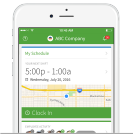Mobile Workforce Management: The Modern Manager’s Guide
Try When I Work for free
Think back to the 1990s.
Workers gathered around the water cooler or in the break room, discussing the latest “Friends” episode, or last night’s game. Then, off to the cubicles until lunch break.
Good times.
But that traditional workforce is fading away, replaced by a mobile workforce. It’s a workforce that won’t have that experience because they’re not confined to a building or a campus.
They’re the “deskless” workforce, connecting through the internet with their mobile devices and laptops, having that same kind of discussion about the latest Netflix show on Slack, in a virtual break room.
Whether you call them mobile, remote, or deskless, the current workforce is one that’s connected digitally instead of in-person, and that can be a challenge for managers.
Once you see the pros (and cons) of a mobile workforce, you’ll see that while the techniques are different, mobile workforce management is still the same: keeping your team connected and moving towards the same goal.
What are the benefits of a mobile workforce?
Working remotely was already the trend, with about 4.7 million people working from home. Then the pandemic kicked it into high gear. Suddenly, businesses had to find ways to let their employees work from home, with 88% of businesses and organizations around the world encouraging remote work.
With this sudden explosion of remote work, the positive benefits quickly emerged.
Access a larger talent pool
Businesses are turning to remote employees for many reasons, but top of the list has to be the ability to hire from a larger pool. No longer are you restricted to finding the best of what’s locally available; the whole world is your oyster.
This is a clear competitive advantage over businesses who can only hire people who live in geographic proximity to the physical location. You can access high-level talent you might not have been able to with the traditional workforce.
Additionally, younger workers prefer to work remotely, and in a labor shortage, offering remote positions makes you stand out from the competition.
Reduce employee stress and expense
Workers who are on the job remotely don’t have to commute to work.
That commute, alone, is a source of significant stress and expense to employees. 50% of employees admit they find commuting stressful, with 45% saying it’s too long. Depending on where employees live, their commute can end up costing companies billions each year.
Getting rid of the work commute is a win for everyone, including the planet.
Decrease costs associated with physical locations
Think of what you pay on rent, equipment, parking, custodial care, maintenance—it’s significant.
When you don’t have a physical location, all of that expense is gone. While you still may need to purchase or reimburse employees for computers, mobile devices, or internet access, it’s still significantly less than brick and mortar overhead.
A mobile workforce can make your business more cost efficient, and it starts here.
What challenges does the mobile worker face at work?
While a mobile workforce has a lot of benefits, there are challenges, too.
Keep in mind that a mobile worker might be working from home, working from the road, or choosing to go to a coffee shop. The challenges each person faces depends on their personality, the setting they work in and the distractions that come with it, and how they respond to all of it.
Communication can suffer
We all know that verbal in-person communication is the best. We can see body language and facial expressions to help us put the words into context. We tend to say things differently in person than we would online.
Mobile teams are going to be mostly using text and written communication (though there will be virtual meetings). Not everyone is skilled at written communication. They write too much, too little, have poor spelling and grammar, are poor at reading comprehension, are sarcastic, are too informal, use too many emoticons—we know how it goes. We all communicate differently, and written communication accentuates this.
Messaging can get lost and relationships can be damaged. Important information goes ignored. You get the communication piece wrong, and the mobile workforce falls apart.
Isolation can affect productivity
Some workers claim they are more productive working from home or out of the office setting. In some studies, this holds true. Working from home can increase productivity up to 13%. Some workers report up to 77% more productivity.
Isolation, and the effects of a lack of socialization, are real concerns for a mobile workforce. Social isolation is tied to depression, lack of sleep, cognitive decline, and reduced physical health. Over time, those will affect productivity. For many people, the workplace is the source of most of their social interaction; removing it is tough.
Not everyone thrives in solitude, and many people don’t realize how much they need the in-person presence and feedback of other people to help them stay productive. Even something as simple as being in a group of people working, with the sounds of productivity, helps spur people on to work.
At home, or wherever they choose to work, there are distractions. Some will try to find places to work (like a coffee shop) where there are other people around.
There’s a lack of workplace rhythms
Working at the office or the shop comes with its own rhythms.
There are break times, meetings, the casual conversations that pop up as you get a cup of coffee from the break room, Friday pizza day—all of these create a daily and weekly structure that helps employees mark off time, feel as if they are accomplishing things, and keep from overworking. They get through the day understanding the rhythms.
Mobile workers lack this input. Without forced or practiced rhythms (e.g. using the Pomodoro technique or time blocking), it’s easy to work to exhaustion or get pulled away by distraction and not finish work at all.
How to manage and empower your mobile workforce
For managers who like to have iron-fisted control over their team, or frequently veer into micromanagement, a mobile workforce is going to be tough.
But if that’s not you, you can empower your team (and reduce your own stress) by trusting your people and following a few tips on what that looks like in action.
Be purposeful about company culture
Employee culture ultimately impacts your bottom line. It trickles into customer experience, productivity, and employee retention.
Creating a great workplace culture is challenging on its own. Trying to do it with a mobile workforce is even more difficult. Culture is about team connection, feeling like you belong, feeling like you’re contributing, and finding joy in the work.
These can all be done with a mobile workforce, but they’ll look different. Virtual parties, celebrating important moments, sending out treats or gift cards as incentive, virtual team-building games—there are lots of options, but you’ll have to be creative.
Give them the right tools
The definition of the “right” tool is simple: it does what needs to be done with the least amount of resistance. Your employees should NEVER have to struggle, fuss, or find workarounds. If your team has to adapt to the tool instead of the tool adapting to how your team works, it’s the wrong tool.
Using a lot of different tools and trying to get them to work together can cause problems.
When I Work has integrated features for ease of use so that scheduling, communication, and payroll integrations happen in one place—instead of forcing you to create an ad hoc system from lots of different vendors. Feel like you’re managing a digital load up to your eyeballs? Using a flexible scheduling system can reduce that load to save you time and reduce stress when you’re building the work schedule.
Signs that your tools need replacing? Employees (or you) aren’t using them much, correctly, or only through workarounds.
Start your free 14-day trial of When I Work! Click here to start scheduling your employees today.

Build in work rhythms
A mobile workforce is still a workforce. Build structure as much as would make sense.
Have your weekly or monthly meetings. Encourage teams to have brainstorming sessions or chat rooms where they can collaborate. Don’t reward overwork; help employees maintain a work-life balance (which is even more difficult when you work from home).
And then, provide the training and tools to help them structure their work day and not get distracted. You may have some employees who do so well working remotely that they get their work done faster than they would have in-person. Don’t penalize that; use that as a guide to help others in structuring their work day.
Rethink how you manage
In person, you could accomplish a huge chunk of your management duties simply by being in the room.
How do you do that when everyone is remote? How do you work effectively with mobile employees?
Mobile workforce management tools, like When I Work, are part of that. It’s software that schedules, tracks location by GPS (where applicable) for clocking in and out, uses real-time communication, and gives your employees a single place to manage their work life.
Management shifts to monitoring results—project completion, customer satisfaction—instead of counting warm bodies in seats. While you still have to make sure people are working when they’re on the clock, your manager’s mindset will have to rely on data and results more than with a traditional workforce.
And you’ll have to learn that empowering your deskless workforce takes trust, but will return amazing results.
Have a great employee assistance program
An employee assistance program (EAP) is always a good idea, and even more so when your workforce is mobile.
EAPs are intended to help employees deal with personal problems that might be affecting their work, their mental health, and their physical health. Whether through counseling, training, or incentives, the goal is to maintain a healthy workforce. An EAP is part of creating that all-important company culture, and in light of concerns about some employees experiencing isolation and mental health issues, is a necessity.
Whether you’re just getting started with the idea of a mobile workforce or are actively working toward it, that’s where the future of jobs is heading. Even if you start with having a partly remote workforce, hoping to transition more over time, you’ll learn how to manage a mobile workforce and stay ahead of the curve.






